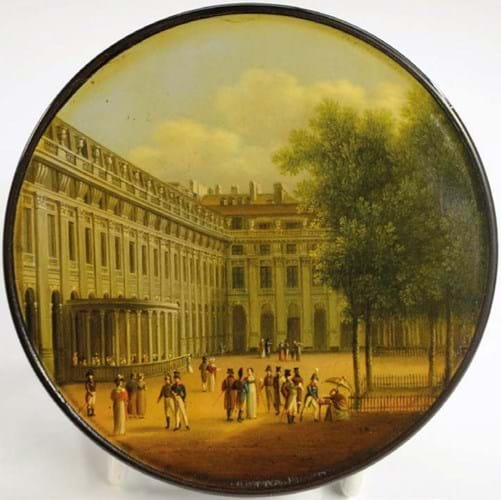
In its pomp, the ‘lacquerware manufactory’ he founded with his father in 1763 employed more than 50 people creating a wide range of papier-mâché and toleware luxuries. ‘Stobwasser-arbeiten’ was sold from the half-timbered ‘Stobwasserhaus’ located on Echternstrasse (it still stands today). Others via a hugely successful branch in Berlin opened in 1772.
The signature Stobwasser production was the flat circular table snuff box decorated with miniature reproductions of popular Italian, French and Dutch paintings of the period. They were much imitated but most are signed inside with a distinctive red script, often with pattern number and sometimes with a subject name.
Examples make periodic appearances at auction. However, few generate quite the reaction of the 4in (10cm) box signed Stobwasser sche Fabrik in Braunschweig and numbered 887 offered for sale at Bamfords in Derby on September 11. Part of a collection of snuff and other boxes, it was decorated with a vignettes titled Vue du jardin du Palais-Royal près de la rotonde. A pen and ink of the same composition and title by Paris artist Charles-François Muller (1789-1855) resides in the Musée Carnavalet.
The box (with a chip to the base) was guaranteed to find many admirers at the estimate of £200-300 but the auctioneers were shocked to see pre-sale bidding via thesaleroom.com had jumped to £16,000 by the morning of the sale. Two collectors from Germany had locked horns and neither was quite finished. Bidding again during the sale, the hammer fell to an online bidder from Brunswick at £20,000 (plus 21% buyer’s premium).
Why such a huge price? It was under Georg Heinrich’s son Johann Heinrich Stobwasser (1740-1829) that the firm employed and trained a succession of jobbing German artists.
Many of these are destined to remain anonymous but they included talents such as the Brunswick landscape artist Pascha Johann Friedrich Weitsch (1723-1803), who ran the Stobwasser painting school, his son Friedrich Georg Weitsch (1758-1828), the portrait painter Johann Christian August Schwartz (1756-1814) and the Icelandic artist Thorstein Ilia Hjaltalin (1771-1817). One of these gifted hands was probably the decorator of this box.















